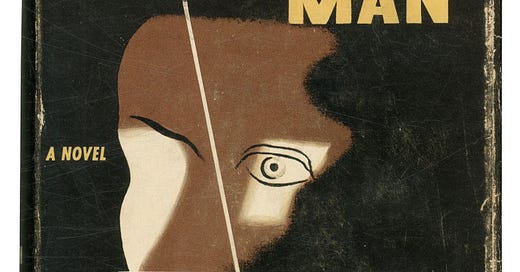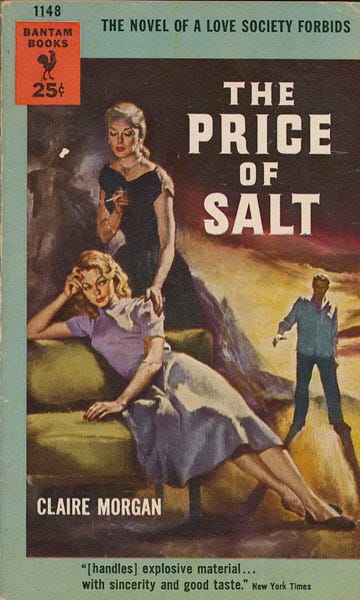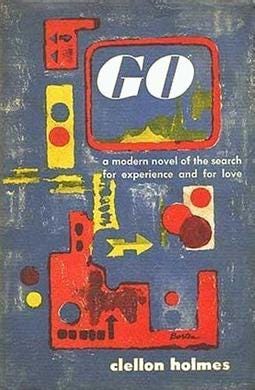[Note: Put cursor over footnote for pop-up.]
Well-known Books:
Invisible Man, Ralph Ellison
The Old Man and the Sea, Ernest Hemingway
East of Eden, John Steinbeck
Other Notable Fiction:
Giant, Edna Ferber 1
A Many-Splendoured Thing, Han Suyin 2
Martha Quest, Doris Lessing 3
The Natural, Bernard Malamud 4
Wise Blood, Flannery O'Connor 5
The Killer Inside Me, Jim Thompson 6
Special notice:
The Diary of a Young Girl [aka The Diary of Anne Frank] Anne Frank (first English-language edition) 7
Spring Fire, Vin Packer 8
Charlotte's Web, E. B. White 9
My List:
Forbidden Notebook, Alba de Céspedes 10
The Price of Salt, Patricia Highsmith (writing as Claire Morgan) 11
Go, John Clellon Holmes 12
The Works of Love, Wright Morris 13
Excellent Women, Barbara Pym 14
The Catherine Wheel, Jean Stafford 15
Player Piano, Kurt Vonnegut, Jr. 16
Ferber was a member of the infamous Algonquin Roundtable—she collaborated with fellow Algonquinite, George S. Kaufman (and others) on a number of plays and musicals, including Stage Door, Dinner at Eight, and Showboat. Her novel, So Big, won the 1925 Pulitzer for Fiction. Altogether, she published several dozen novels, story collections, and nonfiction works, besides the pieces for theater. Giant (her next-to-final novel) is described as “a sweeping generational tale of power, love, cattle barons, and oil tycoons, set in Texas during the first half of the twentieth century.” It was the basis of the classic film of the same name (1956) with Rock Hudson, Elizabeth Taylor, and James Dean.
Wiki: “Rosalie Matilda Kuanghu Chou (1916/1917–2012) was a Chinese-born Eurasian physician and author, better known by her pen name Han Suyin. She wrote in English and French on modern China, set her novels in East and Southeast Asia, and published autobiographical memoirs which covered the span of modern China . . .
In 1944, she went with her daughter to London, where her husband Pao had been posted two years earlier as military attaché, to continue her studies in medicine at the Royal Free Hospital. Pao was subsequently posted to Washington and later to the Manchurian front. In 1947, while she was still in London, her husband died in action during the Chinese Civil War. She . . .went to Hong Kong to practice medicine at the Queen Mary Hospital. There she met and fell in love with Ian Morrison, a married Australian war correspondent based in Singapore, who was killed in Korea in 1950. She portrayed their relationship in the bestselling novel A Many-Splendoured Thing . . . the factual basis of their relationship is documented in her autobiography My House Has Two Doors (1980).”
Doris Lessing, is a towering figure, winner of the 2007 Nobel Prize for Literature, writer of 26 novels, many story collections, plays, books of poetry, and essays and other nonfiction. Martha Quest is the first of the five-volume Children of Violence series. The others: A Proper Marriage (1954), A Ripple from the Storm (1958), Landlocked (1965), and The Four-Gated City (1969).
Malamud's first novel. Tracks baseball prodigy, Roy Hobbs, whose career is sidetracked after being shot by a mysterious woman—loosely based on the shooting and subsequent comeback of Philadelphia Phillies player Eddie Waitkus. Adapted for a film of the same name with Robert Redford (1984). Malamud became a major literary figure in the second half of the 20th C.—fourteen novels, numerous story collections, many awards, including a Pulitzer for The Fixer (1967) in 1967.
We tend to remember Flannery O’Connor as a writer of Southern Gothic short stories, such as the indelible, “A Good Man Is Hard To Find” [her Complete Stories is listed under Birth Year Project: 1971]. But she actually published two novels—the other one is The Violent Bear It Away (1960). Good Reads: “[Wise Blood is a] tale of redemption, retribution, false prophets, blindness, blindings, and wisdoms gives us one of the most riveting characters in twentieth-century American fiction.”
Described by Crime Novels: American Noir of the 1950s as "one of the most blistering and uncompromising crime novels ever written." Thompson wrote a slew of gritty novels from the 1950s to 1980s, many adapted to film.
For most translated works, I use the publication date in the original language. With Anne Frank it's important to note the first English edition as well. The story of the text—its discovery, the versions, the cuts, etc.—is too complex to summarize here [I'll put a link at the end]. The first Dutch edition appeared in June, 1947. An English translation was done in 1950, but was never published. A second translation eventually found it way to Doubleday. It came out in 1952, with an introduction by Eleanor Roosevelt, and became a bestseller.
https://en.wikipedia.org/wiki/The_Diary_of_a_Young_Girl
Marijane Agnes Meaker (along with Ann Bannon and Tereska Torres) was a prime mover in the creation of lesbian pulp fiction. She used various pen names—Vin Packer for twenty crime and mystery books, such as Spring Fire; Ann Aldrich for nonfiction about lesbians; M.E. Kerr for YA fiction; and Mary James for books for younger children. She was given a lifetime achievement award from the American Library Association for her YA literature
New Yorker editor, sublime essayist [The Essays of E. B. White (1977)], reviser/editor of William Strunk, Jr., Elements of Style, stepfather of Roger Angell (New Yorker editor, baseball writer extraordinaire, and a key figure in my writing life) . . . also wrote several classics of children's literature, including Stuart Little (1945) and Charlotte's Web.
Some pig!
[Read his essay, “Once More to the Lake.”]
The notebook/diary is prohibited, first, because it’s been bought on a Sunday when the shop is only allowed to sell tobacco. But this is 1952 and our diarist lives in a small apartment in an unnamed Italian city with her husband and two almost-adult children; she has no safe place to keep it, and writes her entries clandestinely. She and her daughter are poised at the edge of a deep generational divide concerning morals, the role of women, etc. I’m reading this now—the deeper I get the more immersed and impressed I am—and grateful for this new translation by Ann Goldstein brought out by Astra House. It’s good to be reminded that Elena Ferrante was not alone, and that there are many fine novels that would vanish into history were it not for someone’s concentrated attention and persistence.
[And now I’ve finished it and wonder if I’ll read a finer novel this year. The diary format allows a degree of candor and self-analysis that reminds me how superficial many novels are. The story became more and more engaging as the complexities of each character’s situation emerged. Why, I ask myself, as I so often do, did I not know of this novel? Though I know the answer, though the answer is at the heart of my Substack.]
To be perfectly damn honest, I was a little miffed when they made a film of this (Carol, with with Cate Blanchett and Rooney Mara), because a while earlier I’d discovered this obscure, pseudonymous novel of Highsmith’s and now everyone was going to know about it. That sounds ungenerous, forget I said that. Actually I’m happy that writers can write openly about their sexuality/gender identities [see Maurice in Birth Year Project: 1971].
Go is said to be the first Beat novel. Holmes was a close friend of Jack Kerouac—he attributes the term “Beat generation” to a remark of Kerouac’s. The characters in Go are modeled on the same cadre of friends that appear in the writing of Kerouac and others—Allen Ginsberg, Neal Cassaday, William Burroughs, Herebert Huncke, et al. Like the great short story writer, Jack Driscoll, Holmes came from Holyoke, Massachusetts
My first taste of Wright Morris came from my mentor, Bill Kittredge, quoting the opening lines of Ceremony at Lone Tree:
Come to the window. The one at the rear of the Lone Tree Hotel.
Works of Love has its own memorable opener:
In the dry places, men begin to dream.
Nebraska is close to the heart of all Morris’s works—including his photography, for which he is also renowned. One of his spiritual heirs is Kent Haruf (Plainsong, 1999), another under-appreciated writer of the inland West.
A few of the reviews from Good Reads:
Unexpectedly lovely and sad and wise.
Such a strange & beautiful book.
One of the most moving novels in all of American literature. But since Wright Morris never grovels for emotional response, this like all the rest of his work is destined to remain a possession of the few.
https://nebraskaauthors.org/authors/wright-morris
https://www.nytimes.com/2019/07/18/books/enthusiast-wright-morris-peter-orner.html
Those of us desiring to keep worthy books visible and available, especially ones by women, owe a big debt to Virago Books (now celebrating its 50th year in the biz). Under one of their imprints, Virago Modern Classics, they’ve published Muriel Spark, Daphne du Maurier, Ann Petry, Elizabeth Taylor, Rebecca West, Beryl Bainbridge, Stella Gibbons, Mary Renault, Angela Carter, and a slew of others including two of this post’s writers, Patricia Highsmith and Barbara Pym. The New York Times called Excellent Women, Pym’s most famous and most perfect novel. “Beneath the gentle surface . . . is a slow-building comedy, salt wit in a saline drip.”
https://store.virago.co.uk/collections/the-complete-virago-modern-classic-collection
https://en.wikipedia.org/wiki/Barbara_Pym
Since 2019, The Library of America has brought out two volumes of Stafford's work, The Complete Stories, and her three novels, Boston Adventure (1944), The Mountain Lion (1947) and The Catherine Wheel. The New York Times reviewer of the latter began his piece:
As a child, Jean Stafford pledged allegiance only to language. She remained steadfast; in a life dogged by alcoholism and ill health, appalling husbands and, admittedly, a fair amount of chaos of her own making, her prose never lost its force, sheen or sour majesty. What she wanted, she once said, was to communicate “what it’s like to be inside this particular skull.” Forty years after her death, her sentences still gleam like knives.
She was once a popular short story writer for The New Yorker, but faded quickly from the public mind. I feel lucky to have stumbled onto this novel. I feel the same about the novels of two other women of about the same vintage—Penelope Mortimer (The Pumpkin Eater, 1962) and Dorothy Baker (Cassandra at the Wedding, 1962).
The first of Vonnegut’s fourteen novels. It was followed by two others, and The Sirens of Titan (1959) and Mother Night (1962) before Cat’s Cradle (1963) brought him a wide audience. Wiki on Player Piano: “. . . depicts a dystopia of automation partly inspired by the author's time working at General Electric, describing the negative impact technology can have on quality of life. The story takes place in a near-future society that is almost totally mechanized, eliminating the need for human laborers.”










Malamud wrote The Natural while teaching at Oregon State College (since aUniversity, but not while he was there) in Corvallis, where I was born in 1952 when this book was published. My dad worked there in the library before moving to the US Bureau of Commercial Fishers in Seattle when I was 4.
Got it!